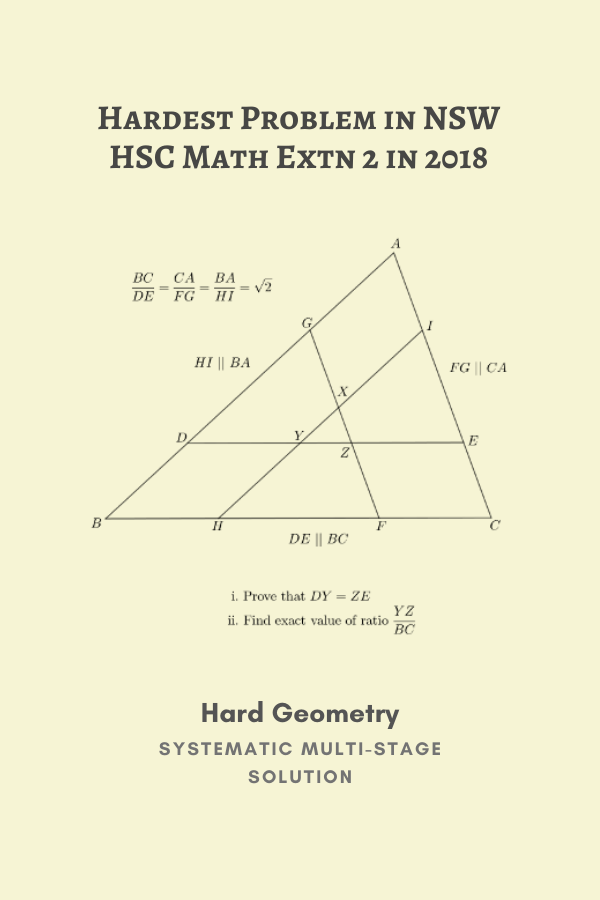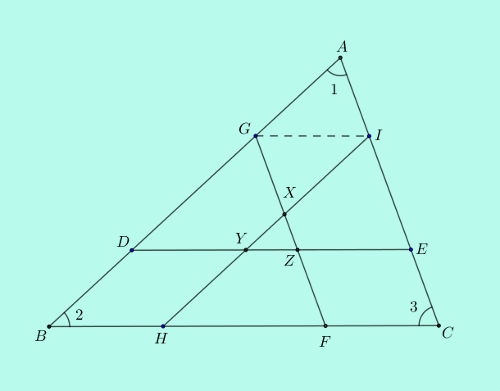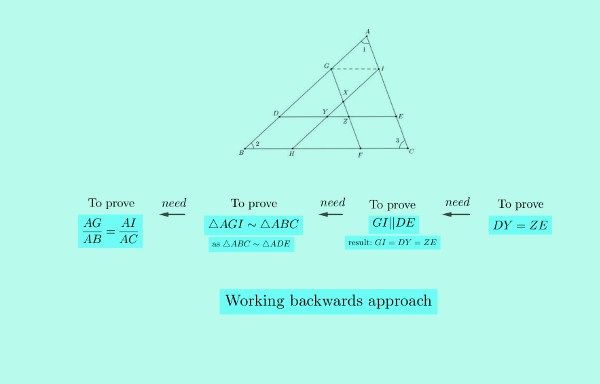A challenging problem solved by identification of the key missing element and working backwards approach

The problem we'll take up this time was reported in The Sydney Morning Heraldas the hardest one in the Math Extension 2 exam paper in NSW HSW 2018 test in Australia. It was the question 16b on Geometry involving a large number of pairs of similar triangles.
Students not used to identify the key missing element from a host of elements spread all around and think strategically and systematically would find it difficult.
Our recommendation: Before going through the solution, make a good attempt to solve it yourself. If you do that, you would surely learn a lot more when you go through the solutions.
The Problem—Question 16b in NSW HSC Math Extension 2 exam in 2018
In $\triangle ABC$, the point $D$ is chosen on side $AB$ and point $E$ is chosen on side $AC$ so that $DE$ is parallel to $BC$ and $\displaystyle\frac{BC}{DE}=\sqrt{2}$.
The process is repeated two more times. Point $F$ is chosen on $BC$ and point $G$ on $BA$ so that $FG$ is parallel to $CA$ and $\displaystyle\frac{CA}{FG}=\sqrt{2}$.
Point $H$ is chosen on side $CB$ and $I$ on $CA$ so that $HI$ is parallel to $BA$ and $\displaystyle\frac{BA}{HI}=\sqrt{2}$.
The segments $FG$ and $HI$ intersect at $X$ and $DE$ and $HI$ intersect at $Y$ and $DE$ and $FG$ intersect at $Z$.

- Prove that, $DY=ZE$.
- Find the exact value of the ratio $\displaystyle\frac{YZ}{BC}$.
Systematic solution to Question 16b in NSW HSC Math Extension 2 exam in 2018: Hard Geometry
We'll first solve the part i of the question.
Solution to Part i of Question 16b in NSW HSC Math Extension 2 exam in 2018
In the first part, we have to show, $DY=ZE$.
With the given figure it is easy to see that if you prove $\triangle DZG$ congruent to $\triangle YEI$, you would get, $DZ=YE$ and then, $DY=ZE$. But it seemed to be some involved proving.
Instead, searching for a simpler solution we identified the key missing element of segment $GI$ that would make the geometric figure more complete and quickly provide us the solution of the first part in a few steps.
This is new element introduction technique that often provided the quickest solution to complicated problems.
The element to be introduced should be such as to make the geometric figure more complete as well as help to solve the problem quickly.
We classify this technique as innovative.
Following this path, points $G$ and $I$ are connected to form line segment $GI$. The resulting graphic that we would use for solution is shown below.

Now focusing on the region of $DY$ and $ZE$, we are not surprised to find $GI$ seemingly parallel to both $DY$ and $ZE$, and if indeed it were so, as common opposite side in two parallelograms $DYIG$ and $ZEIG$, $GI$ would be equal to both $DY$ and $ZE$. It would then act as the intermediary link element between $DY$ and $ZE$. This is the second geometric problem solving concept that plays a key role in solving many difficult problems.
The task is then cut out—you have only to prove that $GI || DE$.
This shouldn’t be difficult from the three sets of equal side ratios in three pairs of similar triangles made similar because of three pairs of parallel sides. But which is the quickest way?
Thinking a bit more, the easiest way identified is to show $\triangle AGI$ similar to $\triangle ABC$. And to do that it is enough to show side ratios, $\displaystyle\frac{AG}{AB}=\frac{AI}{AC}$.
Mark that we are working backwards from final task to previous task to its previous tasks. The following graphic helps to visualize this powerful approach.

This is what we call Working backwards approach, again a powerful general problem solving technique that we use with great effect in solving real world problems to math problems.
With $\displaystyle\frac{AG}{AB}=\frac{AI}{AC}$ and included $\angle 1$ common, the two triangles $\triangle AGI$ and $\triangle ABC$ would be similar.
Now we’ll have to use obviously the technique of connecting two sets of equal side ratios.
Till this point it has been ANALYSIS by strategic geometry problem solving, mathematical reasoning and use of suitable general techniques. Now it is time to actually show how we’ll arrive at the parallelism of $GI$ and $DE$. This is the stage of implementing the analytical results.
First, with $HI || BA$ and $\triangle CHI ∼ \triangle CBA$, ratio of similar sides of the two triangles are equal,
$\displaystyle\frac{CI}{CA}=\frac{CH}{CB}=\frac{HI}{BA}=\frac{1}{\sqrt{2}}$, inverting third given ratio value.
And then with $FG||CA$ and $\triangle FGB ∼ \triangle CAB$, ratio of similar sides of the two triangles are equal,
$\displaystyle\frac{BG}{BA}=\frac{BF}{BC}=\frac{FG}{CA}=\frac{1}{\sqrt{2}}$, inverting the second given ratio value.
So,
$\displaystyle\frac{CI}{CA}=\frac{BG}{BA}=\frac{1}{\sqrt{2}}$.
Subtract all three terms of the chained equation from 1,
$\displaystyle\frac{(CA-CI)}{CA} = \frac{(BA-BG)}{BA} = \displaystyle\frac{\sqrt{2}-1}{\sqrt{2}}$,
Or, $\displaystyle\frac{AG}{AB}=\frac{AI}{AC}=\frac{\sqrt{2}-1}{\sqrt{2}}$.
In triangles $\triangle AGI$ and $\triangle ABC$, ratios of a pair of similar sides are equal with included $\angle 1$ common. The two triangles are then similar and $GI || BC||DE$, as $BC||DE$ given.
$GI$ becomes the common side of the two parallelograms $DYIG$ and $ZEIG$, and so it will be equal to its opposite sides $DY$ and $ZE$,
$GI=DY=ZE$.
Proved.
With this result, solving the part ii shouldn't pose much difficulty.
Solution to Part ii of Question 16b in NSW HSC Math Extension 2 exam in 2018
In the second part, we have to find the exact value of $\displaystyle\frac{YZ}{BC}$, and that will be easy to find because in the already formed parallelogram, $DBHY$,
$DY=BH$.
Let’s clarify.
With $HI||AB$,
$\displaystyle\frac{CI}{AC}=\frac{CH}{BC}=\frac{HI}{AB}=\frac{1}{\sqrt{2}}$. So,
We need only the ratio, $\displaystyle\frac{CH}{BC}=\frac{1}{\sqrt{2}}$,
Subtracting both sides of the equation from 1,
$\displaystyle\frac{BC-CH}{BC}=\frac{\sqrt{2}-1}{\sqrt{2}}$,
Or, $\displaystyle\frac{BH}{BC}=\frac{\sqrt{2}-1}{\sqrt{2}}$.
As $DY=ZE$,
$YZ=DE-2DY=DE-2BH$ in already formed parallelogram $BHYD$.
The desired ratio,
$\displaystyle\frac{YZ}{BC}=\frac{(DE-2BH)}{BC}= \displaystyle\frac{1}{\sqrt{2}}-2\times{\displaystyle\frac{√2 – 1}{\sqrt{2}}}=\frac{3-2√2}{\sqrt{2}}$.
The second part is easier.
Proved.
Key concepts and techniques used: New element introduction technique -- Working backwards approach -- Link element technique -- Triangle similarity conditions -- Ratio of similar side equality in similar triangles.
End note
This is a problem with rich potential of learning because many concepts and techniques were needed to solve the problem step by step systematically.
With clarity on the concepts and techniques, the problem shouldn't pose any difficulty in solving.
Overall, this systematic problem solving approach ensures assured and confident solution in steps.
